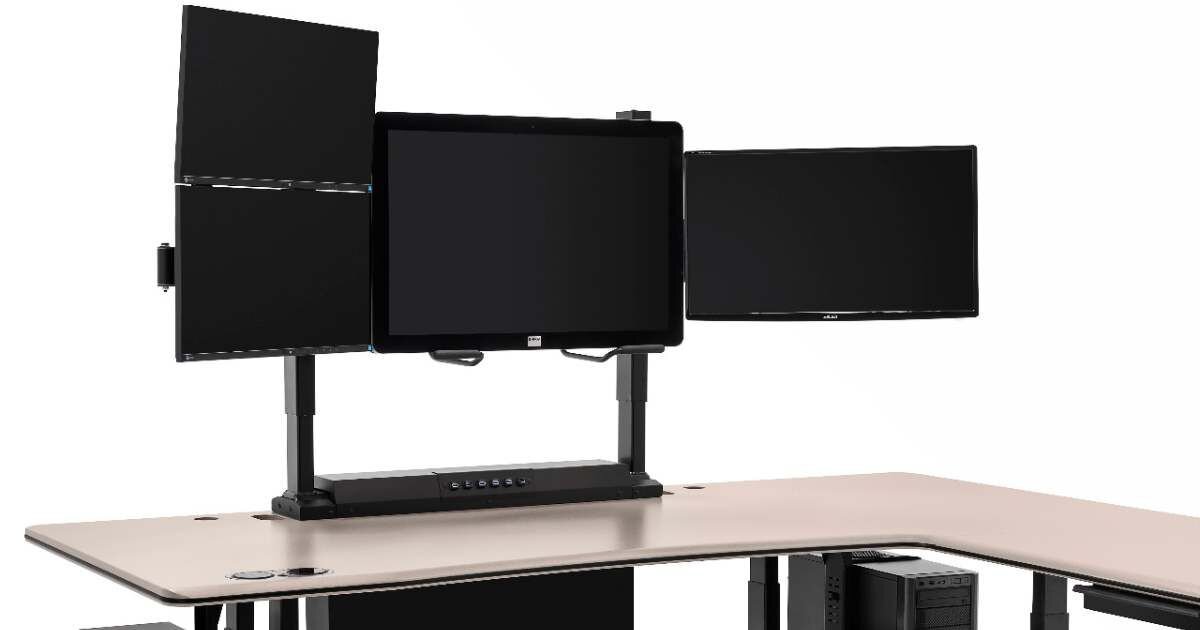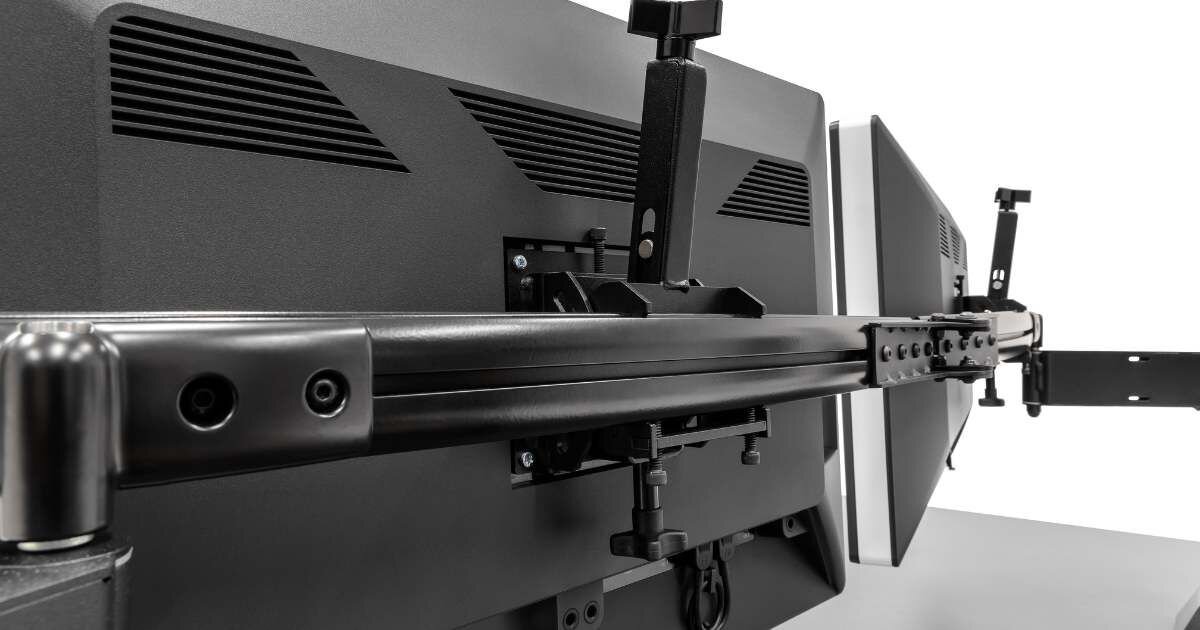
We collect basic website visitor information on this website and store it in cookies. We also utilize Google Analytics to track page view information to assist us in improving our website.

Radiology is a field that demands intense focus, precision, and long hours of concentration. Radiologists spend significant time working at computer workstations, analyzing images, and making critical diagnostic decisions.
That being said, the impact of their work environment on their mental health and well-being is often overlooked. Medscape’s 2022 Physician Burnout & Depression Report surveyed 13,000 U.S. physicians across 29 specialties. Radiology, with 49% of survey respondents reporting burnout, was ranked in the eighth position for medical specialties with the highest degrees of physician burnout.
In this blog post, we will take a look at the psychological impact of ergonomic workstations on radiologists, exploring how a well-designed workspace can contribute to their overall mental health, stress levels, and job satisfaction.
At RedRick Technologies, we design and develop ergonomic workspaces for healthcare professionals that include workstations, monitor mounting solutions, accessories, and peripherals. We also provide ergonomic design services that help organizations implement ergonomic principles for improved space design and functionality. Get in touch and let’s find ways to improve the ergonomic functionality of your workspace.
The workspace design profoundly affects the mental health and well-being of radiologists. A poorly designed workstation can lead to discomfort, fatigue, and increased stress levels, ultimately affecting job satisfaction and overall productivity. Alternatively, a well-designed workspace promotes physical comfort, reduces stress, and enhances job satisfaction.
Ergonomic workstations are designed to optimize comfort, efficiency, and safety in the workplace. They are crucial for radiologists, who spend extended periods sitting and analyzing images on monitors.
These workstations are tailored to:
Support proper posture
Reduce strain on the body
Minimize the risk of musculoskeletal injuries such as neck and back pain
Components Of an Ergonomic Workstation
Height adjustable desk and adjustable chair: Allow users to customize their workstation to their body dimensions and preferred working posture.
Monitor Mounting Systems: Enable users to position monitors at eye level to reduce neck strain and prevent eye fatigue.
Ergonomic keyboard and mouse: Designed to promote natural hand and wrist positions, reducing the risk of repetitive strain injuries.
Ambient Back lighting: Provides adequate and balanced illumination without causing glare or eye strain.
Footrests: Support proper posture and alleviate pressure on the lower back during prolonged sitting and standing.
Benefits Of Ergonomic Design for Radiologists
Reduced risk of musculoskeletal disorders: Proper ergonomic design helps prevent injuries such as neck pain, back pain, and carpal tunnel syndrome.
Improved comfort and productivity: Ergonomic workstations enhance user comfort, allowing radiologists to focus on their work without distractions or discomfort.
Enhanced job satisfaction: Ergonomic workstations help boost radiologist morale, job satisfaction, and retention rates by fostering a comfortable and supportive work environment.
Better overall health and well-being: Investing in ergonomic workstations showcases dedication to radiologists' health, curbing absenteeism, lowering healthcare expenses, and fostering a positive work culture.
Radiologists face significant mental health challenges due to the demanding nature of their work, including high caseloads, long hours, and exposure to distressing patient cases.
There is a clear link between workspace design and radiologists' mental well-being, as ergonomic workstations can alleviate physical discomfort, reduce stress levels, and promote a conducive environment for focused and efficient work.
Ergonomic design focuses on creating a comfortable and supportive workspace, which can help reduce physical discomfort and prevent stress-related injuries. Proper ergonomic setup, including adjustable desktops and monitor positions, promotes relaxation and reduces tension in the body, contributing to lower stress levels for radiologists.
One often overlooked aspect of burnout is physical strain. While it may not be the primary cause of radiologist burnout, physical discomfort is a significant exacerbating factor. And in a field where long hours are spent analyzing images and dictating reports, the physical toll on radiologists can be substantial.
Ergonomic workstations offer a solution to this problem, as they reduce the physical strain that comes with the demands of radiology work.
Ergonomic workstations tailor the workspace to natural body posture, reducing injury risks and chronic discomfort from prolonged sitting or standing. Adjusting monitor height, chair support, and tool placement eases physical strain, indirectly benefiting radiologists' mental and emotional health by reducing frustration and fatigue and enhancing job satisfaction.
Conducive Environment for Stress Management
Ergonomic workstations create a conducive environment for stress management by reducing distractions and promoting focus on tasks. Proper lighting and noise reduction measures further enhance the calming atmosphere.
Strategies for Minimizing Stress Through Workspace Optimization
Workspace optimization involves organizing the workstation layout and equipment to minimize clutter and facilitate smooth workflow, reducing cognitive load and stress.
Implementing other time management techniques, such as scheduling regular breaks and prioritizing tasks, can help radiologists maintain a healthy work-life balance and prevent burnout.
A comfortable workspace provided by ergonomic design fosters a sense of well-being and contentment among radiologists, increasing job satisfaction. Radiologists who work in ergonomic environments are more likely to feel valued by their employers and experience greater job satisfaction.
Increased Morale and Motivation
Ergonomic workstations increase morale and motivation among radiologists by reducing physical discomfort and fatigue, allowing them to focus on their work more effectively. Feeling supported by their employers by providing ergonomic workstations can boost radiologists' morale and motivation, leading to higher job satisfaction and performance.
A Positive Work Culture Through Ergonomic Initiatives
Employers who prioritize ergonomic initiatives demonstrate a commitment to their employees' well-being and foster a positive work culture. By investing in ergonomic workstations and promoting a healthy work environment, employers can create a supportive atmosphere that enhances job satisfaction and employee retention.
Ensure that workstations are adjustable to accommodate different body types and preferences.
Provide proper support for the back, wrists, and neck to prevent strain and injury.
Position monitors at the optimum distance, height, and angle to reduce neck strain and minimize eye fatigue, in both sitting and standing positions.
Encourage the use of ergonomic accessories such as footrests to promote comfort and proper posture.
At the core of our philosophy is the understanding that every workspace (and each radiologist) has unique needs. This drives our commitment to delivering customized, user-friendly solutions, particularly in complex environments like radiology reading rooms and learning spaces.
Our design proposals and product offerings are tailor-made, aligning perfectly with each client’s requirements. This customization is critical in settings like radiology reading rooms, where the precision and accuracy of diagnoses heavily rely on the comfort and efficiency of the workspace.
A key principle in our designs is prioritizing ease of use. We understand that the best ergonomic solutions integrate seamlessly into the daily routines of professionals.
To this end, our products are adjustable, intuitive, and robust. This durability ensures that they stand up to the demands of a busy radiology department, providing prolonged comfort and support over time.

Height adjustable desktop (standard/critical feature)
Our recommended/standard range of adjustment is 24-49.5” above the floor
ANSI BIFMA standard of 22-48” is also available
The size and shape of a desktop are limitless and determined by physical space available, computer hardware to be hosted, and user preference.

Height adjustment (standard/critical feature)
Motorized height adjustment providing 12” of vertical range
All monitors adjust simultaneously
Virtually any monitor configuration can be accommodated
Focal distance adjustment (standard/critical feature)
Effortless manual adjustment, found to be the most intuitive and easy-to-engage method, providing 16” of horizontal forward/back range as well as 60 degrees of side-to-side swivel
Virtually any monitor configuration can be accommodated
Our monitor mounts can handle the heaviest monitor setups. These monitor mounts are designed to accommodate large, high-resolution displays and multiple screens for demanding tasks.
Unlike traditional “split-level” or “keyboard tray” models, RedRick’s mounts allow for single-work-surface solutions that retain maximum useable space, while providing superior, intuitive, and easy ergonomic adjustment.
At RedRick Technologies, we design and develop ergonomic workspaces for healthcare professionals that include workstations, monitor mounting solutions, accessories, and peripherals. We also provide ergonomic design services that help organizations implement ergonomic principles for improved space design and functionality. Get in touch and let’s find ways to improve the ergonomic functionality of your workspace.